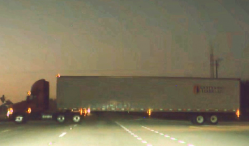
— The Jeremy Banner Tesla lawsuit is likely heading for a 2024 trial after the judge ruled a jury should decide if Tesla's Autopilot system, “created a foreseeable zone of risk that posed a general threat of harm to others.”
Jeremy Banner, 50, was killed when his 2018 Tesla Model 3 was traveling on a Florida highway with the driver-assist system Autopilot engaged.
The March 1, 2019, Delray Beach crash occurred when a tractor-trailer was crossing the southbound lanes of US 441 as the 2018 Model 3 slammed into the trailer of a semi-truck, traveled under the trailer and stopped 1,600 feet away. The roof of the Tesla was sheared which instantly killed Banner.
Data from the Model 3 showed Jeremy Banner activated Autopilot about 10 seconds before the crash.
Autopilot includes Traffic-Aware Cruise Control, Auto Lane Change and Autosteer which use cameras, radar and sensors to determine how to steer the vehicle. However, a Tesla driver is warned to keep at least one hand on the steering wheel.
An alert will activate if Autopilot does not detect a driver's hand on the steering wheel after a period of time.
The National Transportation Safety Board investigated the Tesla Banner crash and determined the Model 3 was traveling nearly 70 mph when it slammed into the trailer. The Model 3 took no evasive action, didn't activate the brakes and neither did Jeremy Banner.
(Photo above shows the tractor-trailer crossing the highway 1 second before impact)
The NTSB determined the crash was caused by the tractor-trailer driver who didn't yield to highway traffic, by Jeremy Banner's trust in technology and by the design of Autopilot.
The NTSB determined the Autopilot design was a problem because Tesla didn't block the use of Autopilot in circumstances where it shouldn't be engaged. In short, Autopilot allowed Banner to ignore the surroundings and the highway.
The Jeremy Banner Tesla lawsuit alleges he bought into Tesla's advertising regarding Autopilot, referencing a 2016 Tesla video advertisement for Autopilot.
According to the Tesla video:
“The person in the driver’s seat is only there for legal reasons. He is not doing anything. The car is driving itself.”
The video shows a Tesla traveling on winding roads as it stops in traffic and seems to be driving itself with no hands on the steering wheel and no feet touching the pedals.
However, Tesla's employees testified the vehicle had mapping program software not available to the public. The unedited Autopilot video also shows it took several takes and was heavily edited.
The employees also testified the vehicle, “still performed poorly and even ran into a fence while filming.”
Jeremy Banner Tesla Lawsuit Will Continue
Judge Reid Scott ruled the Tesla lawsuit, filed by Jeremy Banner's wife, Kim, will continue based on a "genuine dispute” whether Tesla falsely marketed its Autopilot system.
The decision was guided by other crashes which involved Autopilot.
Though Tesla referenced owner's manuals which warn drivers to stay aware and keep their hands on the steering wheel, Judge Scott said after reviewing the evidence, he could not “imagine how some ordinary consumers would not have some belief that the Tesla vehicles were capable of driving themselves hands free.”
The Jeremy Banner Tesla lawsuit was filed in the Circuit Court of the 15th Judicial Circuit for Palm Beach County Florida - Kim Banner, as Personal Representative of the Estate of Jeremy Banner, v. Tesla Inc., et al.
Kim Banner is represented by Lytal, Reiter, Smith, Ivey & Fronrath.




